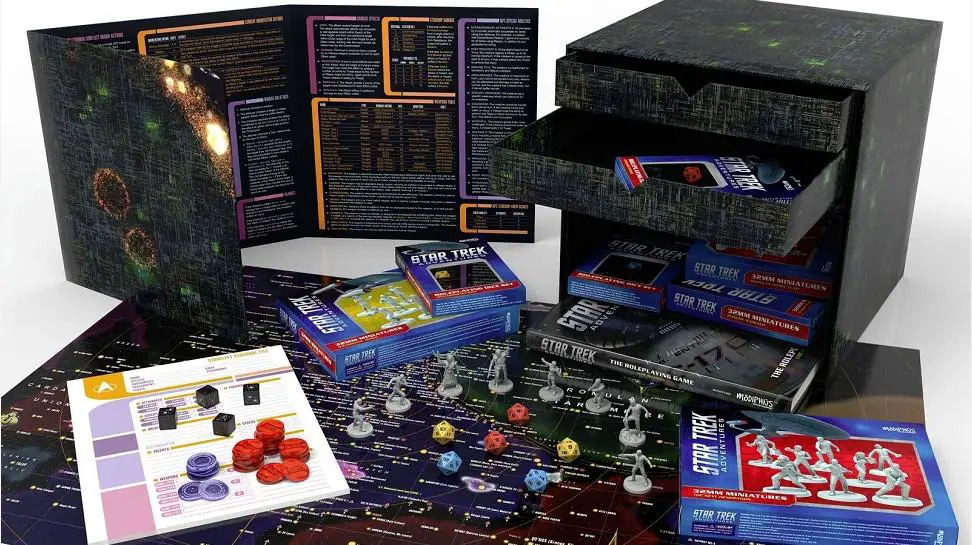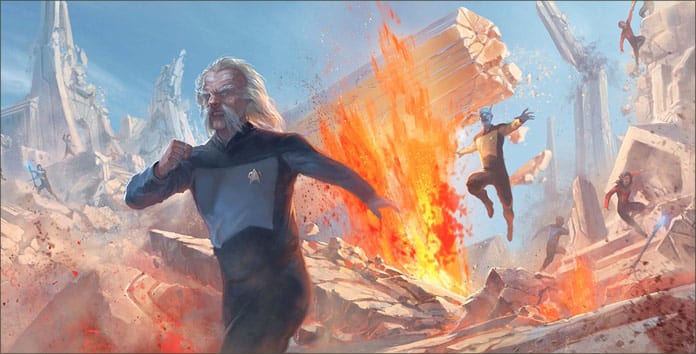I am a big Star Trek fan, and have been for most of my life. I watched the TV shows, watched the movies, played the video games, and read the books. One of my favorite Christmas gifts was a stuffed tribble that I still have. The one thing missing from my nerdy collection of Star Trek gear was a tabletop RPG. I knew that one existed, made by Last Unicorn Games, but by the time I started getting interested in tabletop games, that game was already difficult to find. Even if I had been able to find it, that specific game also had a reputation of being nigh unplayable. I was still willing to give it a shot anyway until two years ago. That’s when I saw a pre-order for the new Star Trek Adventures game by Modiphius Entertainment go up.
I fell in love with the game, sight unseen. Not only did it seem like exactly what I was looking for, the special five hundred dollar collector’s edition came in a giant Borg cube box. Clearly, these people knew who they were marketing to. I kept my sanity and did not buy the Borg cube special edition, but I did buy the PDFs eventually, and started running a game. And while it didn’t meet my initial wild hopes for the game, it’s more than adequate as a Star Trek game and a very good game on it’s own.

Game Mechanics
At its most basic, the mechanics of Star Trek Adventures is a dice pool system. Before each challenge, the GM (game master) decides which combination of Attributes (Control, Daring, Presence, Fitness, Insight, or Reason) and Discipline (Command, Conn, Security, Engineering, Science, or Medicine) you have to roll and the difficulty of the task. To succeed, you must roll d20s (twenty sided dice) under your Attribute+Discipline and have more or equal successes to the difficulty. For example, let’s say you are trying to fly a shuttle through an asteroid belt. The GM says that would require a Control+Conn roll at a difficulty of 1. Looking at your stats, you see that your Control 10, and your Conn is four. Added together, that is 14. You would roll two twenty sided dice, trying to get at least one roll under 14.
Now, there will be times where the difficulty is higher than the number of dice you roll to start with. The difficulty might be four, and you only ever start by rolling two d20s. Fortunately, there are multiple ways to increase the number of dice you can use and the number of successes you can get. One of the first things you can do is have specific Focus. Focuses represent fields where your character has studied or has an edge in a certain skill, and they make it so that whenever you roll under your Discipline, you get two successes. Going back to our previous example, if your character had the Focus of Small Craft, they would get a bonus to their successes if they were flying a shuttle and rolled under their Conn score of four.
Another way you help improve your odds is by buying more dice using Momentum. Momentum is a pool shared between all the players and allows them to buy more dice, re-roll dice, and create situations more favorable to the players. There are a limited number of ways to refill the Momentum pool, and not all of them will always be available. One option that is always open to players though is giving the GM Threat. Threat acts as a Momentum pool for the NPCs, allowing the GM to ramp up certain challenges, or create difficulties where none existed before.
This push and pull between the Momentum and Threat pools can create very interesting situations, as the players sometimes have to budget their Momentum for maximum effectiveness. The GM meanwhile can always make the situation more perilous as long as he has Threat. These pools help really nail the sort of rising tension that you get in episodes of Star Trek.
Another element that the game takes from the TV show and brings into the playing experience is the idea of the extended task. In Star Trek they are always racing to fix the engines, discover a cure for a disease, remove mines from the hull of the ship, etc. Extended tasks are also a good way to help keep the entire crew on their toes. Thanks to the omnipresent communicator, there is no real danger in splitting the party and having them all attempt different tasks at the same time. Extended tasks help put everyone on a time limit and keep the game going.

Of course, none of this really matters a great deal if you don’t have a ship to travel the galaxy in. Fortunately, Star Trek Adventures has that covered as well. To build a ship, first the party must select a base frame. These can range from the well known like the Galaxy class or the Constitution class, to the more obscure like the Akira class. After selecting a frame, the players can then choose a mission profile for their ship, as well as different refits and talents for their ship. This allows for a good variety of customization and lets players really feel like this this their ship and not one taken from a movie or television show.
The Good
As I’ve hinted at in the previous section, one of the best things about this game is how much attention it pays to making the experience seem like Star Trek. Even the book itself has the LCARS computer aesthetic from The Next Generation. Once you get into the rules, you’ll see that all the examples come from specific episodes of Star Trek. I went back and checked a few times and could even find the exact scene that they were referencing. Small details like that add to the immersion aspect of the game.
Another way the game adds to the immersion is in its character and stat generation. The primary method of character generation is through the Lifepath system, which allows players to pick their species, home planet, relationship with parents, and the general arc of their Starfleet career. This allows characters to have very natural and believable backstories, and the stats generated are very well rounded. In Star Trek Adventures, characters need to be well rounded, as they never know what sort of roll the GM may call on them to make.
Another trait that sets this game apart from others for the better is the ability to switch the attributes you use during your roll. To do so, all you need to do is tell the GM what attribute and discipline combination you want to use, and why it would apply to this situation. If the GM approves, you can make the roll. Going by our previous example, you could use the Control+Conn roll. However, if your Daring is higher than your Control, you could ask the GM if you could fly the ship manually. If they agree, you now have a much better roll chance. Very few RPGs allow you to change what dice you get to roll on the fly like that.
Now, perhaps your character gets injured or has to remain on board the ship because they need to perform some task. Not to worry, as one of the other great things about this game is the ‘supporting characters’. Supporting characters bridge the gap between non-playable character and full PC. They have their own stats and fill roles that the PCs can’t quite handle. Supporting characters can also level up, increasing their abilities, and turning them from (in Star Trek terms) red shirts to mauve shirts. In some cases they could even become full fledged characters of their own. This gives the player the ability to always be doing something in game rather than sitting around and waiting.
The Bad
As much as there is to praise about this game, there are several flaws in it. The most obvious flaw is what attracted me to the game in the first place: the incredibly strong connections to Star Trek. While other Trekkies like me will understand the book quickly, people unfamiliar with the setting will be scratching their heads. This becomes particularly evident in a few of the pre-published adventures, where some plot elements and characters that I consider common knowledge were in fact obscure trivia to most non-fans of the franchise. I had to stop and explain to some players what certain things were or how certain concepts worked. The rulebook itself didn’t help, as it assumed the reader would already know what a self-sealing stem bolt was.
Furthermore, even looking for those concepts in the core rulebook is at times a herculean task. There are rules for mechanics, but the explanation of what those mechanics do or how they impact gameplay doesn’t come till over a hundred pages later. The biggest example of this occurs when Extended tasks are first mentioned on page 91, but their full explanation and breakdown aren’t covered until you reach the GM section, on page 282. In addition to having rules scattered across the book, the first three chapters are just lore and world building. The history of the Federation, Starfleet’s goals, the history of Starfleet…it goes on like that for over seventy pages. I’m no stranger to RPGs frontloading their lore but generally speaking, you want to have at least a basic explanation of how character creation works and what the basic dice roll is within the first thirty pages.
Perhaps the game’s worst example of confusing rules and too much fluff is the section on ‘social combat’. The social combat section comes before the the rules on actual combat and is about five pages long. These pages describe the different actions you can take in ‘social combat’ and what the results of them might be. However, there is no description of how the social combat actually works mechanically. Reading through a second and third time, I realized that there actually weren’t any rules for ‘social combat’. It is five pages of disguised fluff. Good fluff, but fluff nonetheless. The fact that it takes two or three re-reads to realize this is not a point in this game’s favor.
The Final Frontier
In spite of the confusing rules and poorly organized books, Star Trek Adventures is still worth playing. Once you get past the initial hurdle, it’s quite a fun game. The Momentum and Threat pools are fun mechanics to use and play with. The Lifepath system is one of the most fun character creators I’ve used in a while, and the supporting characters make sure that no one is ever bored during game play. But most of all, Star Trek Adventures is a good licensed Star Trek game. Modiphius Entertainment continues to support the game with more books and a ‘living campaign’ that promises to keep updating. All in all, I highly recommend this game to anyone who wants to boldly go where no man has gone before.

